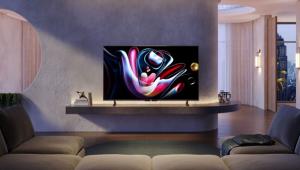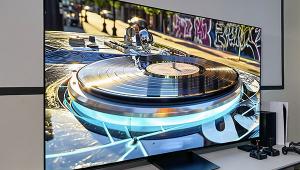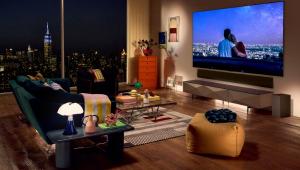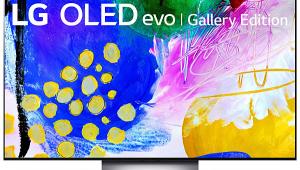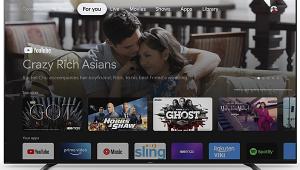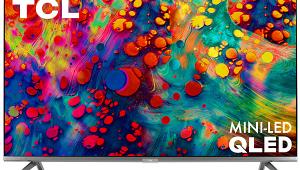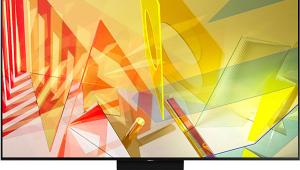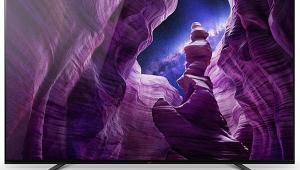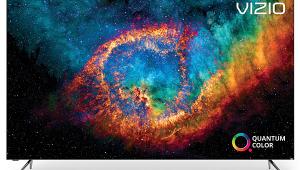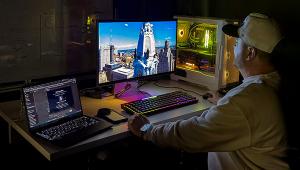Samsung 75-Inch QN75QN900F 8K TV Review
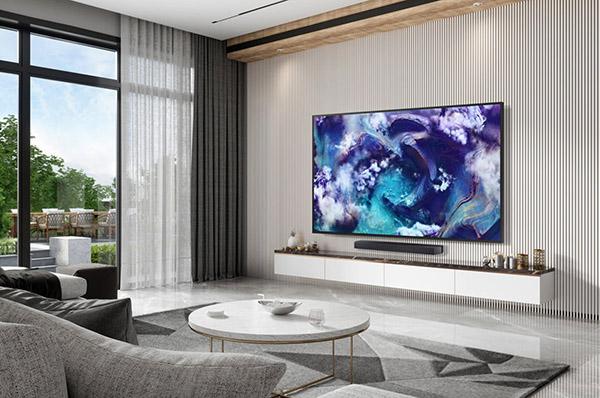
AT A GLANCE
Plus
• Highly bright HDR peak luminance
• Crisp and clear upscaled images filling the screen 33.2 million (7680 x 4320) pixels
• Loaded package of advanced gaming features with AI Auto Game Mode
• Attractive thin chamfered metal picture-frame-like bezel
• Useful feature assortment including ATSC 3.0 over-the-air tuning
• One of the best smart TV interfaces available
Minus
• Anti-glare screen film lifts blooming/haloing effects
• Slight black-level crushing
• Continued dearth of native 8K content and omission of next-gen codecs like VVC and EVC
• Lacks support for Dolby Vision HDR.
THE VERDICT
Samsung's QN75QN900F Neo QLED 8K TV impresses with bright HDR, new smart features, and AI game mode, offering stunning visuals from 4K and Full HD sources. Its faster speed and responsiveness make it a top choice for gaming, while the chamfered metal bezel provide an 8K solution for fans of Samsung’s picture-frame-like The Frame TVs.
Samsung’s 75-inch QN900D 8K Neo QLED TV was one of our favorite mini-LED TVs of last year and we are pleased to report its successor—the QN75QN900F 8K Neo QLED—is even better. In fact, we found it not only a better performing television, but a better deal than its predecessor, and overall better option that Samsung’s 2025 flagship 8K wireless 8K Neo QLED version in the QN75QN990F reviewed here a few weeks ago.
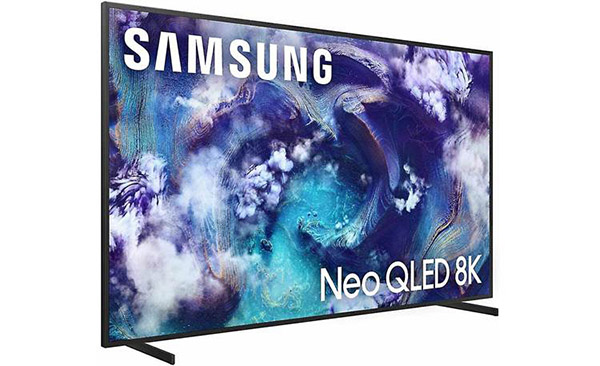
Just as we saw in its 2024 equivalent model, the QN900F delivers a brilliantly bright, colorful and detailed picture from most content with one of the few niggling issues continuing to be that you’ll have to look wide and long to find any native 8K content to play on it. In addition, Samsung doesn’t support the newer VVC and EVC video codecs, which are likely to eventually be used to stream native 8K content once it becomes available.
However, Samsung continues to improve picture processing and upscaling, and this year’s upscaled 4K UHD movies look more three dimensional and naturally bright than ever.
If you can live without native 8K UHD content for a couple of years, the performance improvements that include excellent Vision AI 8K upscaling of lower-resolution images and more than a $2,000 lower introductory price of $3,999 suggested retail from a year ago make the Samsung QN75QN900F a recommended buy. As this was written, Samsung was even offering the model with an additional $200 promotional savings for a limited time.
You’ll have to decide if all this, minus the native 8K content availability, gets you more excited than having a similarly sized, less-expensive premium 4K OLED or QD-OLED model that is slimmer, offers even wider viewing angles and perfect black with minimal blooming. But we also note that high-end video streaming service Kaleidescape recently joined the 8K Association, signaling the possible availability of some 8K movies to stream soon, if you are so inclined. Additionally, when you get into screen sizes above 65 inches, well-upscaled 8K resolution starts to pay dividends in clarity of some content over 4K screens. For that reason, you might even want to consider getting this model’s 85-inch big brother for a $5,499 MSRP. Alternatively, you can save a few bucks and go smaller with the QN65QN900F for $3,299 MSRP (check prices for promotional savings), although the picture quality differences over a higher quality premium 4K TV will be less obvious at sizes below 75 inches.
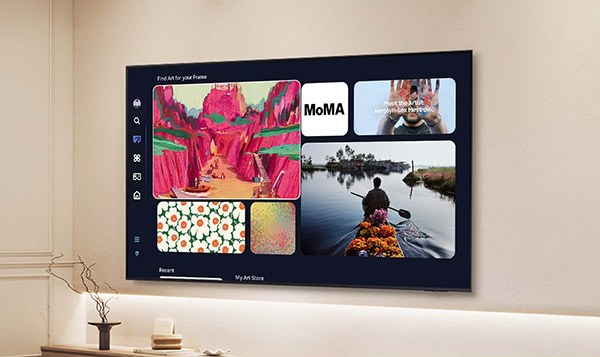
The 75QN900F continues to offer a svelte mini-LED design while stepping up the advanced gaming speed from 144Hz last year to 165Hz. The trade-off from last year’s model is the elimination of the external One Connect box, which is now only available in 8K from the flagship wireless One Connect QN990F series. Nicely, the 8K Neo QLED technology continues to deliver excellent quantum dot color converter technology to enable rich high-color volume from the display’s approximately 1,400 local dimming zones. This is down from nearly 1,900 we counted last year, but the panel continues to provide very good contrast with only slightly more shadow detail crushing and blooming than a year ago, as HDR luminance levels continued to measure at nearly 2,400 nits.
The screen produces very life-like HDR specular highlights in theatrical appearing film-based HDR content while delivering unusually bright SDR highlights and very clear, live video for sports and live news events.
Features
Samsung continues to use its powerful Neural Quantum 8K AI Processor (Gen. 2) to drive Samsung’s new and improved Vision AI-enhanced picture and AI-sound processing. Among other things, system has evolved to enable more personalization of pictures and sound to help viewers engage more deeply with the action.
The system uses multi-layered neural networks to analyze and enhance video scene-by-scene, and optimize the picture using tools that include, “Real Depth Enhancer Pro” that increases foreground contrast to make content feel more lifelike and detailed from upscaled 4K HDR and SDR content.
A selectable Adaptive Picture mode is included to analyze the room lighting and adjust the image brightness and color hues, accordingly.
Finally, the set’s Motion Xelerator Pro functions uses AI to adjust up to 165Hz advanced gaming content for minimized motion blur. For movies and TV programming, the set’s panel tops out with a 120Hz native refresh rate.
Meanwhile, the AI-enhancements help viewers interact with the content they are viewing to conduct real-time research on the actors on screen or to get access to recommendations on other programs available through a “Click to Search” function. This year, users can even follow foreign language dialog from live broadcasts using on-screen captions that provide various language translations in real-time using an AI-based “Live Translate” feature.
Samsung also brings back TV gesture control of the set in a more compelling and more private way through “Universal Gesture” control that registers commands from hand motions when the user is wearing a Samsung Galaxy Watch (sold separately). Previous approaches to gesture commands have required built-in or add-on cameras, which raised some security conerns.
As we saw last year, the TVs advanced 8K AI video processing cleaned up and expanded the resolution of native 4K UHD content very well, but the 75-inch model we tested didn’t entirely clean up content shot on lesser-quality cameras or in lower-resolution formats.
For example, the opening sequence from the Full HD Blu-ray Disc version of BBC’s Planet Earth displayed some color banding issues inside the CGI halo from the sunshine around the curvature of the slowly revolving earth. The large screen together with additional 8K pixels requiring line duplication presented somewhat softened focus images in lower resolution SD and HD—like those typical in faces on some YouTube videos.
Many of the features for 2025 are driven by Samsung’s 8K UHD NQ8 AI Gen 2 "Neural Quantum" processor. This continues to deliver crisp image detail from most source content. The processor drives systems including 8K AI Upscaling to help present lower-resolution content blown up on 8K screens with fewer distracting artifacts; AI Motion Enhancer to help reduce things like ball distortion in live sports coverage, while automatically detecting the type of sport being shown in order to more accurately apply deep learning adjustment to the type of ball, puck etc. on the screen. The new Real Depth Enhancer Pro system leverages AI power to enhance detail in fast-moving scenes by more accurately adjusting the wider array of mini-LED backlight zones.
Samsung also includes AI Auto HDR Remastering intended to improve 4K color and contrast using AI-based algorithms to generate brighter highlights in non-HDR content.
Design
The QN900F series gets a design refresh in 2025 as Samsung tries to make the screen resemble a picture frame. This involved widening the black metal bezel trim slightly to 0.5 inches with a chamfered border like a framed painting. To complete the picture, Samsung also makes available still images of classic art and photographs from the Samsung Art Store to play on screen when not used to watch programs. As mentioned, Samsung has dropped the external One Connect Box and placed the input/output ports on the back of the screen, which adds about a half-inch to the 1.5-inch overall panel depth. Users will have to connect game consoles, Blu-ray Disc players and set-top boxes using the more conventional location—off the right side of the screen. Despite the change, the panel thickness measures less than 2-inches deep for easy placement on a wall mount.
Unlike the pedestal stand in the QN990F series, the QN900F series uses a pair of right-angle stand feet which can be set up for wide, stable foot separation on large furniture or closer together (13-inches apart) under the center of the screen for short placement surface widths. In the narrow foot placement, the screen does have a more noticeable panel wobble when bumped or nudged, which should be a consideration in homes with young playful children or pets. The stand also allows a choice of screen elevation positions enabling placement of the screen chin flat against the top of the stand feet or up higher for clearance to accommodate a sound bar.
Smarter TV
One of the more exciting announcements concerning Samsung’s Tizen smart TV OS in 2025 was the company’s newly announced promise to provide set purchasers with seven years of software updates, as available, keeping the smart TV features from becoming too quickly made obsolete. This has been among the bigger criticisms of the company’s sets in recent years when compared to competitors using third-party platforms like Google TV, Fire TV or Roku TV.
At the same time, the system keeps its visually attractive and easy-to-control interface designed around a diminutive Samsung SolarCell Remote. The small candy bar shaped controller is equipped with solar panel collectors on the back to capture sun or room lighting to keep the battery re-charged. The palm-sized controller continues to deliver snappy navigation and selection of on-screen programming and app options as well as TV menu settings. Alternatively, users have the option of one-handed control using minimal button selections including a mic activation button to enable taking voice commands (based on either Samsung’s Bixby or Amazon’s Alexa voice-controlled AI platforms). Additionally, the set can connect to external Google Assistant AI voice-controlled devices.
As mentioned, the Tizen platform also builds in a gesture control feature enabling the use of hand movements from users wearing a compatible (and optional) Galaxy Smart Watch to engage basic set operations. Additionally, users too preoccupied to look for the Solar Cell remote can also activate always-on far-field mics built into the TV to pick up voice commands without lifting a finger.
As in past years, the smart TV app and settings navigation is performed with the remote hand unit using a large circular directional navigation pad on the minimal button layout. Other buttons include home and playback along with volume and channel rockers. Fast access buttons are also included for Amazon Prime Video, Netflix, Samsung TV Plus and this year YouTube replaces the Disney+ button from last year. You’ll have to go to the on-screen app to find the House of Mouse.
In addition to new AI-features including the previously mentioned AI Live Translate and Click to Search, the AI-feature additions include a new Generative Wallpaper feature that can produce screensaver images to reflect the look of a desired mood.
The Tizen menu system once again gets a slightly new look from the central home menu which is now designed to more effectively “learn” the user’s habits and preferences to be more useful and engaging over time. The home screen also carries a fast-access link to the Gaming Hub page to quickly get into gaming preferences and options. As in the past, the Tizen library of app selections continues to be among the largest in the market. Nicely, the QN900F is one of the few TV models available in 2025 including a built-in ATSC 3.0 broadcast tuner to access over-the-air channels, many of which are free to view, so far, and are promised to one-day carry programming in HDR, 4K UHD and possible better. They also offer broadcasters the ability to carry some of the latest and greatest multi-channel audio surround sound channels using the Dolby AC-4 protocol.
As in previous iterations the OS platform enables interaction with multiple smart home platforms and devices through Samsung SmartThings and Apple AirPlay 2 protocols. Users can also purchase an aftermarket USB camera for video conferencing applications using multiview features to conduct video calls or use various health and fitness apps to consult with health and fitness professionals or measure and monitor workout progress.
Inputs
Now lacking a One Connect box, the QN900F places four HDMI 2.1 inputs on the back of the television facing out of the right side of the screen. This includes a now virtually ubiquitous eARC/ARC port for use with sound bars or home theater setups. Each HDMI port supports up to 4K/120p HDR10, 4K gaming up to 165Hz, Variable Refresh Rate, FreeSync Premium Pro and Auto Low Latency Mode. Other ports include: two USB-A connectors, an “Ex-Link” RS-232 serial port, antenna/cable port (to support the internal ATSC 1.0/3.0 tuners), Toslink optical audio port and a LAN (Ethernet) port.
HDR
Peak HDR10 luminance peaked in a 10% white window pattern at an eye-squinting 2,361 nits measured in Portrait Display’s Calman software. This is virtually the same reading we saw in last year’s QN900D but the peak readings were much lower in smaller window sizes.
Support for High Dynamic Range (HDR) content covers standard HDR10, HDR10+ (Adaptive/Gaming), and HLG profiles. Samsung omits Dolby Vision support in its TVs, but those dynamic metadata signals will automatically default to static HDR10 mode when played on a Samsung set. The differences between Dolby Vision and HDR10 are very subtle, and most won’t notice anything is missing. If you want a full dynamic metadata HDR experience, you can look for HDR10+ supported movies and programs to play on this set, but again, the differences with HDR10 are not extreme.
We measured HDR10 peak luminance exceeding 2,361 nits from a 10% D65 white window test pattern with the TV’s picture mode set to Movie Mode (similar results were measured in Filmmaker Mode). We counted around 1,400 local dimming zones, which is similar to last year, controlling the thousands of mini-LED back lights to help the television achieve excellent contrast performance for an LCD-based display.
Measurements were taken using Portrait Display's C6-HDR colorimeter, Murideo Six-G test pattern generator and the latest version of Portrait Displays Calman software.
Just as last year, some blooming and shadow detail crushing is visible viewing test patterns in the Spears & Munsil 4K UHD Blu-ray disc set. This is typical of displays using LED back lighting. However, in real-world viewing the set presented the faint swirling mist in the sometimes difficult- to render evil wizard attack sequence from the HD 1080p Blu-ray version of Harry Potter & the Deathly Hollows Part 2.
We continued to notice some crushing of stars at low brightness levels in the opening title sequence of the UHD Blu-ray version of The Martian and some milky clouding around moving star clusters in the star field test pattern from the Spears & Munsil 4K UHD Blu-ray test disc. If blooming control on deep inky black backgrounds are critical, you might want to also look at OLED displays like Samsung’s 2025 4K S95F Quantum OLED, or any OLED TV from Sony and LG, but this will require trading off some of the QN900D’s peak luminance performance.
Where we were very impressed once again was with the application of Samsung’s matte anti-glare film used to reduce reflections and widen viewing angles. We found off-angle viewing to be slightly wider than last year, and side-angle sunlight reflections were less intrusive than seen on the flagship QN990F series. Meanwhile, we found contrast and colors hold up well for an LCD TV at horizontal and vertical angles.
Wide P3 Color
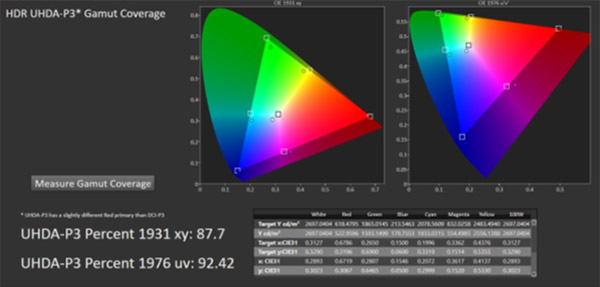
Measured out-of-box HDR P3 color gamut coverage using Portrait Displays HDR evaluation workflow.
The 75QN900F presents the pro-level P3 wide color gamut recommendation very well, though slightly under the measurements from last year’s QN900D. We measured the QN900F’s P3 covering 87.73% of the 1931 CIE xy axis and 92.42% the CIE 1976 uv coordinates. This is close enough to the 90% threshold of the P3 gamut to qualify as a “premium UHD TV” as established by the Ultra HD Alliance of content industry creators and electronics manufacturers. Colors once again appear natural and well saturated for most HDR content.
As last year, Samsung offers viewers the option of viewing static or dynamic tone mapping to control color presentation and detail from shades that are outside the television’s range. This works quite well where required but can be excessive with some material, and as mentioned, the set reproduces most of the P3 colors your likely to encounter today. When in Filmmaker Mode static tone mapping is triggered automatically to present the color vibrancy intended by the director. The set’s dynamic tone mapping adds a realistic overall appearance where peak color brightness begins to roll off.
As we’ve tested in similar QN900 series models for several years now, the set displays colors of reef fish from the Ultra HD Blu-ray of the BBC's Blue Planet II brilliantly with rich and well saturated tones even under continually flashing points of bright HDR sunlight penetrating the crystal-clear water.
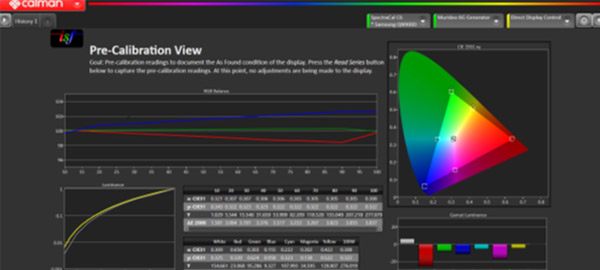
Calman pre-calibration view of the QN75QN900F showing SDR in “Movie” Picture Mode. Post calibration Delta E errors averaged 2.9, which is generally undetectable to the eye.
Standard dynamic range (SDR) images were also nicely bright and accurate after calibrating for gamma and white point, with average Delta E errors below 3, and not generally detectable to the eye.
Motion Handling
The QN900F offers a range of motion processing options to sharpen image clarity in fast moving content and to smooth image judder in camera pans, as long as the picture mode is not set to Filmmaker Mode of course. For video gamers, the set will handle up to native 165Hz content, where available, and the set supports motion for movies and video programs with a native 240Hz refresh rate.
Speed For Gaming
The QN900F series is a powerful gaming display for casual gamers and seasoned pros, alike. For novices as well as advanced console and PC gamers, all four of the HDMI 2.1 inputs on the QN900F series come ready to play. Each one will now support up to 165Hz frame rates from supporting devices on titles to present competitively fast gaming with smooth motion visuals using Samsung Game Motion Plus processing. Those without an available console or connected PC can still play games directly through the television using the Gaming Hub that lets player stream games and interact with an optional compatible third-party controller.
All HDMI inputs also support the now obligatory Auto Low Latency Mode (ALLM) that can be set up to auto detect an incoming game signal and, with the Game Mode setting engaged, the TV set will enter AI Auto Game Mode. This uses updated algorithms to instantly optimize the settings for the best parameters for the game title and genre. After the game starts playing, the AI engine will then engage and match the performance to the most appropriate picture/sound settings. The television further supports HDR Gaming Interest Group (HGiG) compliance for accurate calibration of tone-mapping detail and shading.
Our tests revealed the 75QN900F delivered a blazing fast 11ms lag time with a 60Hz signal. The set also supports variable refresh rate (VRR) and FreeSync Premium Pro for the appropriate content. FreeSync Premium Pro auto engages when a compatible PC video card is detected.
For those needing confirmation of the proper settings at any given moment, Samsung continues to offer its Game Bar on-screen menu that allows easily double-checking settings to make the necessary adjustments for frame rate, proper HDR or fine-tuning wireless headsets. Additionally, an on-screen Minimap Zoom feature helps to easily map the game view without interrupting the playing action.
Finally, a Super Ultrawide GameView feature lets gamers adjust the aspect ratio of the visual from 21:9 to 32:9 and move the screen position to eye level for compatible PC games.
Channeling Multi-Channel Sound
The Samsung 75QN900F is equipped with an internal 4.2.2-channel 70-Watt sound system, which has been reduced from last year. Still, the system helps deliver an impactful audio performance from the speakers placed within the constraints of the panel depth, while effectively using AI to adjust for the variables of the listening space.
The QN900F series incorporates Samsung’s Object Tracking Sound+ processing with Dolby Atmos to make sounds seem to move in sync with characters and objects on screen for an extra level of realism and immersion into the content. Meanwhile, Adaptive Sound Pro continually optimizes the sound as needed, based on the current scene.
Samsung once again employs its Q-Symphony Pro circuitry to get a fuller sound stage with more accurate synching of the internal TV sound with external wireless speakers or supporting Samsung Q-Symphony sound bars. This feature will integrate the speakers in the TV with the external device drivers, including subwoofer and rear channels, where applicable, to expand the sound stage for an enveloping sound experience, particularly when Dolby Atmos surround sound titles are played.
When using the TV’s internal speakers, the set presents clear dialog using Active Voice Amplifier Pro technology which gives a nice boost when AI Mode is engaged. This helps lift clarity on-the-fly against conflicting background noise, although the overall sound from the TV’s speakers alone lacks the depth of tone and punch you will get from a quality external Dolby Atmos home theater speaker system or sound bar, particularly a Samsung Q-Symphony enabled model. Other features include Bluetooth 5.3 wireless audio streaming to a compatible speaker or set of headphones. Unfortunately, while the TV will decode Dolby Atmos and Dolby Digital Plus internally, fans of DTS surround sound codecs will need a supporting external AV receiver or sound bar for decoding.
Other audio features include: an internal equalizer that helps users tweak the tone of the set’s internal speakers to personal preference.
We found the TV's internal speakers presented a nicely wide sound field with a somewhat boxy/hollow tone that seems to be emited from bottom of the screen. If you can’t add a sound bar or external home theater system, the set’s speakers will get the job done.
We didn't have a Q-Symphony supporting sound bar on hand to evaluate this year’s application, but we expect it to will significantly improve the overall immersive experience as it has done since its introduction.
Conclusion
Like last year, the Samsung 75-inch 75QN900F 8K Neo QLED Mini-LED TV is an excellent home theater display that continues to include an internal ATSC 3.0 NextGen TV tuner for the latest over-the-air broadcast technologies. This is likely to become more important in time as U.S. TV broadcasters push for a sunset to today’s ATSC 1.0 broadcasts to open available bandwidth for exciting features including 4K resolution and next-gen multi-channel AC-4 surround sound. The picture quality of the 75QN900F has been appreciable improved over last year, primarily through the use of new advanced Samsung Vision AI picture processing technologies. The brightness levels are similarly high to last year and color gamut coverage continues to rank above the “premium” threshold of 90% coverage of the P3 wide color gamut, though below the nearly 100% coverage in Samsung’s 2025 S95S flagship QD-OLED series. It also provides a large cache of weapons for gaming both from connected devices and streamed directly through the TV from a host of the most popular game-streaming apps. Pricing for the 75-inch model is now more than $2,000 less than seen in the equivalent model a year ago, and if you have the discretionary income to swing it, we don’t think you’ll be disappointed with this 8K model in its larger (75- and 85-inch) iterations, even it may be a few years before meaningful native 8K movies and TV programs are available.
If you are intrigued by the notion of having an 8K TV, Samsung will be one of the few options available to you. You’ll pay more for this extra resolution than you will with a premium 4K UHD model, but we expect to see some real bargains during key promotional periods this year. Advanced gamers will have the ability to compete on a very large, crystal clear screen. But once again, the value proposition and 8K TV offers is a matter for legitimate debate. Value-focused premium TV shoppers should also look at one of Samsung's 2025 4K QD-OLED TVs for a similarly excellent picture and feature package.
The Samsung QN75QN900F used for this review was a company loan.
- Log in or register to post comments


